Pitfalls You Should Avoid When Developing a mHealth App

Predictable means preventable. This statement is relevant for the majority of the business if not for all, yet when it comes to healthcare we need to be as attentive to details as possible because we are dealing with one of the most important things people have – their health. During our experience, we covered mhealth app development from A to Z, and in this article, we would like to share our opinion about what challenges may arise when you start your development, as well as our experience in overcoming them.
Pitfall 1. Not Understanding the Market. Is It Going Up/Down?
Sounds obvious, yet relevant. A deep understanding of the market and its trends gives you the view of perspective. First things first.
Sorting out the notions. mHealth -What’s that?
Mobile health (mHealth) resembles a health/ medical services accessible from mobile devices. Sounds complicated? In fact, it’s not. Simply put, mHealth unites all applications that anyhow represent or deal with the medical/health industry. Examples here can include apps for patient monitoring, access to medical records, symptom checkers, medical calendars, fitness, meditation, condition management apps and so on.
While numbers about the market size may vary significantly from one research company to another, all of them agree about the uprising trend. For instance, according to the Grand View Research market will grow at CAGR 25.7% reaching USD 151.57 billion by 2025. Global Market Insights predict 38.5% growth over the upcoming 6 years from 2019 to 2025 resulting in more than USD 280 billion. The real value lies somewhere in between. The main idea here, that the mHealth market is growing, with people becoming more and more health-conscious, and the countries becoming wealthier, forming a perfect time to launch mHealth applications.
By the way, mHealth apps are the top-funded category in the healthcare tech.
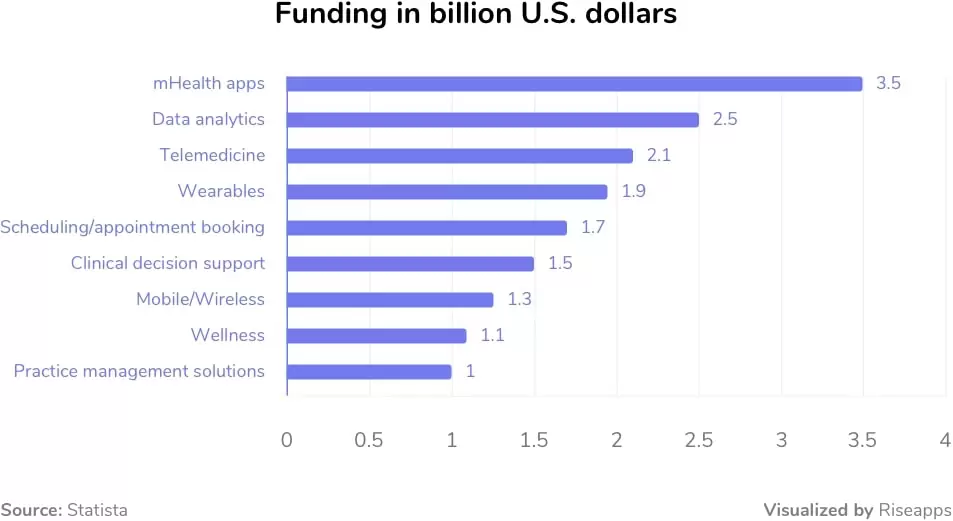
For those of you willing to dive a bit deeper into the digital health market analytics, check this article.
Moving forward.
Pitfall 2. Not Knowing the Supply and Demand
Getting to know your target user is one of the most vital parts of any product/service development project. The better you know the key parameters of your target user, the more chances your app get noticed and downloaded.
As the niche for mobile health is huge, the app stores are already flooded with a wide variety of health applications. For instance, let’s check the number of apps in this segment in the App Store.
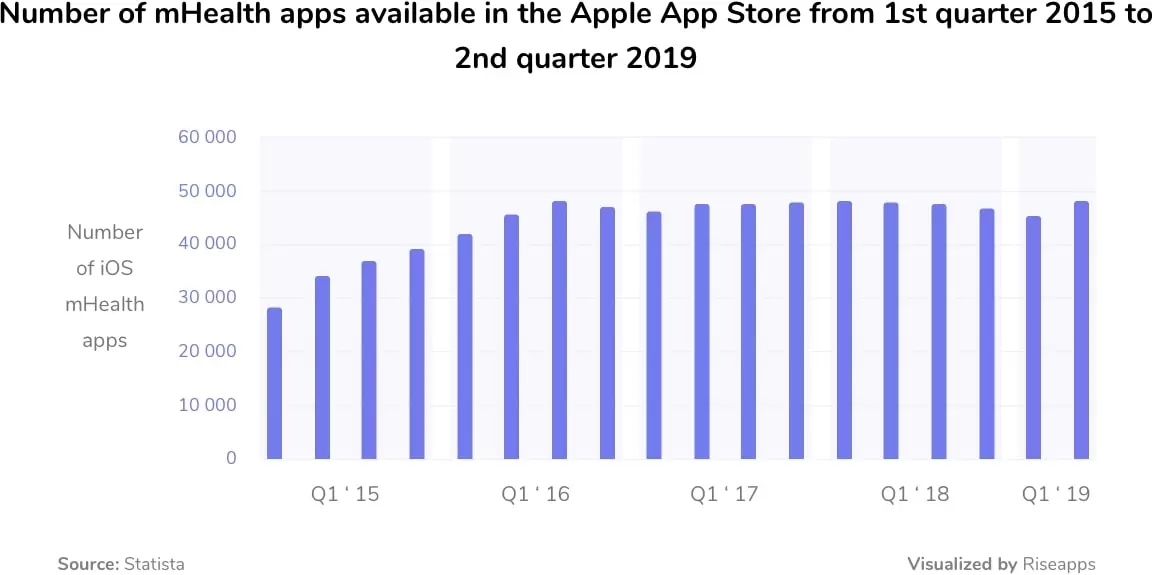
Almost 50k apps are available for download (and this is only for iOS). You need to stand out. You can do this in many ways. The first things that come to mind are an implementation of new features, offering extra services, making an app extremely user-friendly. Still what features fall under “new” and “extra” categories. You need to understand what is already on the mHealth market, what is the supply, and what is the demand. In order to get an understanding of these 2 key market parameters – you’d better conduct deep market research. Keep reading to get an overview of what’s happening in the mhealth app development industry.
Supply
According to the Similar Web ranking in the US, the most popular app in the free category for iOS is Calm, an app for meditation and relaxation. The second place is given to MyFitnessPal – an app in the fitness and nutrition section. In the paid section the leading app is The Wonder Weeks, which helps to track the baby’s mental health development.
Please find the top 10 free and paid apps for iOS below.

The rating may differ from country to country, thus, for you to get inspired check Similar Web statistics and check whether your competitors are created the most popular app in your county.
As we can see from the mHealth market, all mHealth apps can be put into groups according to target users and by the purpose of this app. 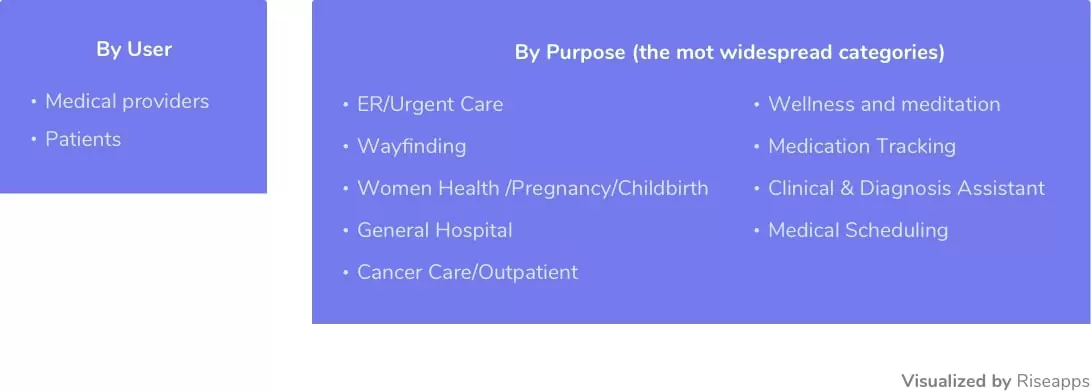 To learn more about each type of mHealth apps check this article.
To learn more about each type of mHealth apps check this article.
Demand
As we can see even from the ratings above, the most widespread category is wellness and fitness. To learn more about this niche, we recommend reading the previous article about how to develop a fitness app. However, the number of condition management apps are increasing rapidly, now representing 40% of all health-related apps.
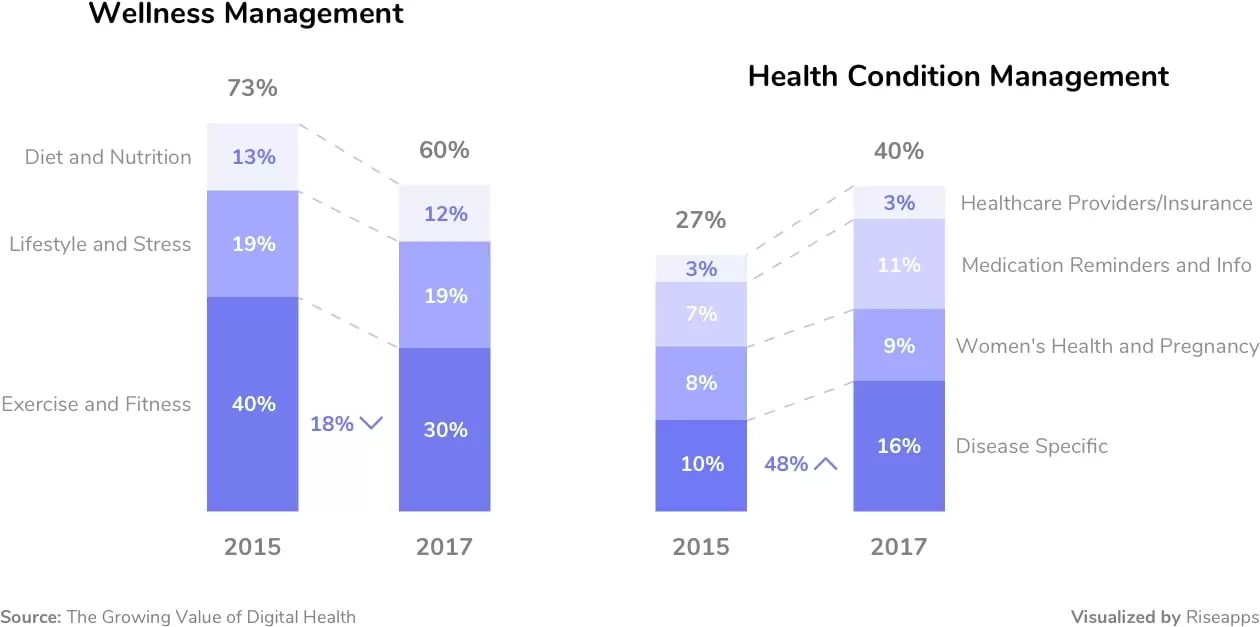
There is one more interesting trend, revealed by Deloitte in its recent survey. A third of consumers are willing to use app that for identifying symptoms and for health coaching.
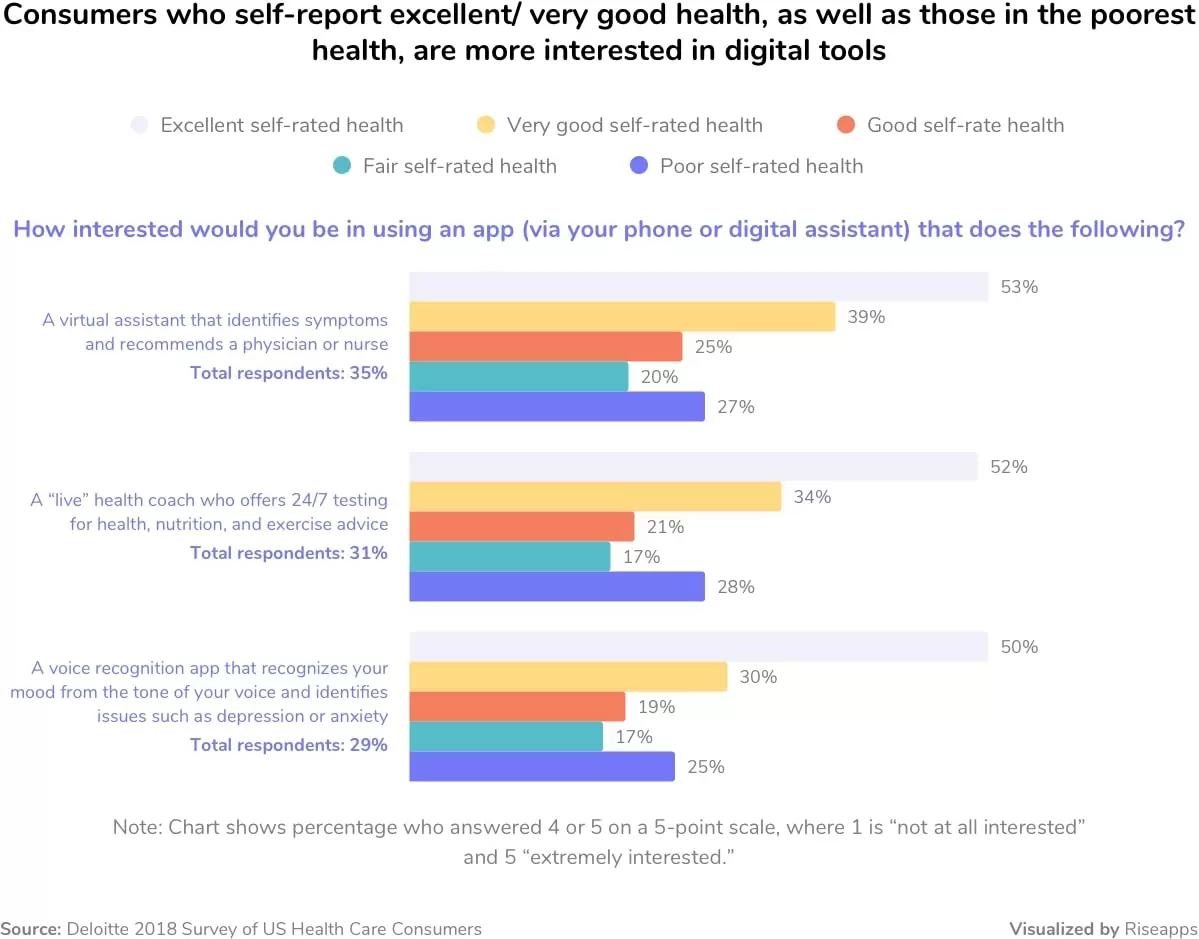
Collecting relevant data and understanding global health consumer trends, will help you create a valuable app that people will be willing to download.
From the development perspective, a portrait of your target audience will define not only the features of your app but the design as well. Color perception, fronts, size of the buttons are just some of the design elements that must be tuned to the target audience to provide accessibility to your users.
And last but not least, it is vital to get an understanding of the location of the target audience. Unfortunately, access to the internet is not as easy in some regions. The app might be great, it helps people to achieve their goals, still, they are not able to use it, as it demands stable internet connection and doesn’t work offline. This tiny, at first glance, detail may ruin all ROI strategy.
Pitfall 3. Not Paying Enough Attention to the Security of mHealth Apps
The majority of healthcare applications deal with sensitive patient data. Thus, there are different governmental regulations, emphasizing on the importance of proper data protection. You can find a lot of apps created for the healthcare sector, saying that they are HIPAA compliant. It means that they are protecting user data from leakage and misusage.
Regulations will vary from country to country, still, if your app deals with one of the following types of data, we recommend you conduct compliance research prior to app development and to identify all applicable regulations in your target region.
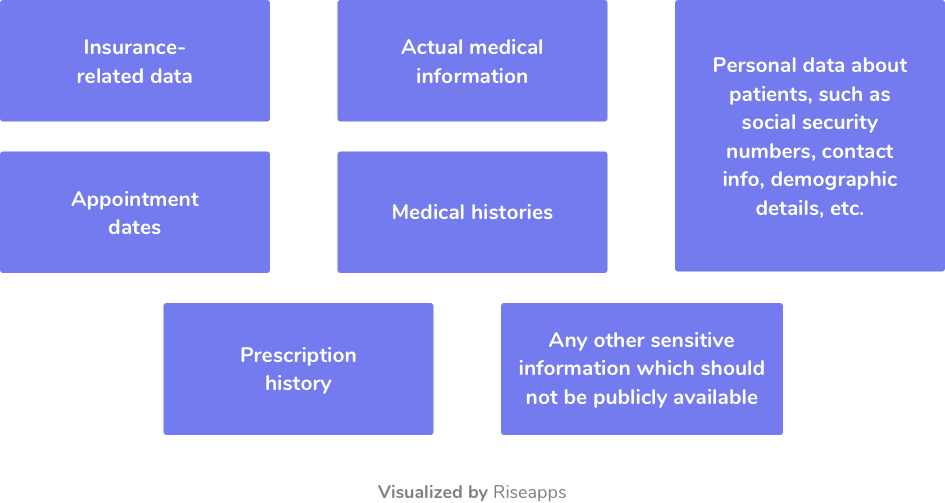
To protect data, ask your developers to include the most effective way to protect sensitive data – encryption. Typically, you might be interested in encrypting places of data storage and transmitting.

Pitfall 4. Not Thinking about the Interoperability and Usability
Interoperability
Both patients and doctors in the majority of countries have access to various mobile devices. Still, there is a challenge of integration. Will your app work seamlessly with other medical hardware, a third-party device or a wearable? It is your responsibility to make sure it will work perfectly together and have simple and understandable integration.
To overcome this potential pitfall, you need to conduct proper research to find out if it is possible to connect your app to third-party hardware making sure relevant APIs and SDKs are already available, and are possible to implement.
Usability
Product designers and marketing teams get excited about features and screens, but when it comes to usability, more doesn’t always mean better. This holds true particularly in medical design, where usability can literally be a matter of life and death.
Your hired mhealth app development company should focus on designing to reduce confusion for safety. This may mean conscious, diligent editing: to limit and channel operator safety-related choices as much as possible; to provide extremely simple, single-decision screens at key points in the interface when choice is necessary; and to shift more complex tasks to areas where they can be accessed by advanced users as needed without impacting critical workflow.
Pitfall 5. Not Dedicating Enough Time for Testing
Once you get the feel and touch an app on one of the demos, the natural desire is to get it to the market asap. Following these vibes, and seeing the finish line, it’s easy to miss the most valuable part – the testing. Proper testing will guarantee your app algorithms perform the way they should, it connects to hardware and transfers data in a relevant way, the app can withstand the particular bandwidth and what’s more important it won’t do any harm to users, by transferring the wrong data from the medical device to the app, leading to wrong medical treatment. For example, a pump programmed to deliver medication might kill a patient from a use error.
How Do We Avoid Pitfalls When Going for mHealth App Development?
We, at Riseapps, have already worked with a number of mHealth applications and here is what we typically do to help our clients avoid all 7 pitfalls and get stable and reliable software products.
| Pitfall | How to avoid |
| #1. Not Understanding the Market | Prior to the development process, we go through the discovery phase with each of our clients. During this phase, we make sure all stakeholders are on the same page about the market potential, target audience, their needs, and pains. Sometimes it happens, that we start working with predictions about the users’ needs, but as a result, we come to the opposite understanding what will work for the chosen target audience. As a result of the discovery phase, you as a client get the wireframes, clickable prototypes that can be tested on the target group of people. After testing is complete, all necessary changes are added to the specification of the app. |
| #2. Not Knowing the Supply and Demand | |
| #3. Not Paying Enough Attention to Security | Our developers make sure the backend of the app is built according to HIPPA regulations, data is encrypted, and access to the device is protected by the password. We typically use cloud services by Amazon, and add two-way data encryption to manage access to the files in the database, and data transfers. |
| #4. Not Thinking about the Interoperability and Usability | At the discovery phase, we are working in the tight cooperation with our clients, discussing all possible scenarios of how the app will be used. At this stage, the developers typically understand whether there will be a technical possibility to guarantee seamless integration with the third-party hardware, and what can be done to achieve needed interoperability. |
| #5. Not Dedicating Enough Time for Testing | Our QA engineers run various tests, including unit testing, that help us make sure in-app algorithms run smoothly and correctly. |
Wrapping Up
The devil is not as black as it is painted, it is in detail. The key thing to omit any of the said pitfalls is to make thorough planning and get a trusted team on your side with the previous experience in developing applications for healthcare. Here we would like to stress that it would be better to deal with the experienced custom mhealth app development team, not the scattered developers. It will pay off as people in the experienced team know how to work together, have a specific sequence of actions and have already done that several times.
Time is now to start your first steps on the way to building successful applications, that make people healthier.
P.S. Be honest and open in communication with your developers. The more information they have about your project, the better result you will receive in the end.
Contact Us







